Lednice–Valtice Cultural Landscape
| Lednice-Valtice Cultural Landscape | |
|---|---|
| Name as inscribed on the World Heritage List | |
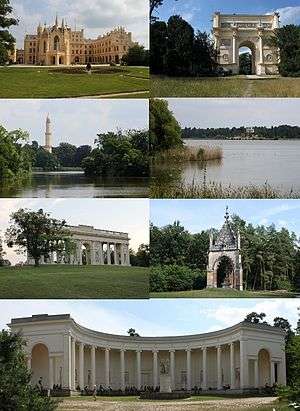 | |
| Type | Cultural |
| Criteria | i, ii, iv |
| Reference | 763 |
| UNESCO region | Europe and North America |
| Inscription history | |
| Inscription | 1996 (20th Session) |
The Lednice-Valtice Cultural Landscape (also Lednice-Valtice Area or Lednice-Valtice Complex, Czech: Lednicko-valtický areál) is a cultural-natural landscape complex of 283.09 square kilometres (109.30 sq mi) in the Lednice and Valtice areas of the South Moravian Region, near Břeclav in the Czech Republic.
The Lednice-Valtice Area is registered in the list of monuments protected as World Heritage Sites (WHS) by UNESCO. It is adjacent to the Pálava Landscape Protected Area (Pálava Biosphere Reserve), a WHS registered by UNESCO several years before. The close proximity of two cultural landscapes protected by UNESCO is unique.
History
The House of Liechtenstein acquired a castle in Lednice in 1249, which marked the beginning of their settlement in the area. It remained the principal Liechtenstein residence for 700 years, until 1939 and World War II.
17th—19th centuries
The Dukes of Liechtenstein transformed their properties into one large and designed private park between the 17th and 20th centuries. During the 19th century, the Dukes continued transforming the area as a large traditional English landscape park. The Baroque and Gothic Revival style architecture of their chateaux are married with smaller buildings and a landscape that was fashioned according to the English principles of landscape architecture.
In 1715 these two chateaux (castles) were connected by a landscape alée and road, later renamed for the poet Petr Bezruč. The Lednice Ponds (Lednické rybníky) are situated between the villages of Valtice, Lednice, and Hlohovec; as are the Mlýnský, Prostřední, Hlohovecký, and Nesyt Ponds. A substantial part of the cultural landscape complex is covered in pine forests, known as the "Pine−wood"(Boří les), and in areas adjacent to the River Dyje with riparian forests.
20th century
In the 20th century the region became part of new Czechoslovakia The Liechtenstein family opposed the annexation of Czech territory in the fascist Sudetenland by Nazi Germany, and as a consequence their properties were confiscated by the Nazis, and the family then relocated to Vaduz in 1939. After World War II the family made several legal attempts for restitution of the properties. However, they had passed post-war into ownership by the new Soviet Czechoslovakia. Of course its Communist government did not support returning large estates to exiled aristocratic landowners.
After the Czechoslovakian Velvet Revolution in 1992, the Liechtenstein descendants again renewed legal attempts for restitution, which were denied by the Czech state, the present day owner of the properties. [1]
Features
The principal elements are:
- Chateau Valtice and its contiguous town/village of Valtice.
- Chateau Lednice Castle and its contiguous village of Lednice.
- The village of Hlohovec.
Pavilions and follies
In addition to the castles, there are a many large to small residential pavilions located throughout the designed landscape, often serving as chateau or hunting lodges.[2]
- The Colonnade − Rajsna (German: Reistna)
— a Neoclassical colonnade on the top of a hill ridge above Valtice (like a gloriette) from the 1810s to 1820s
- Belvedere
— a belvedere landscape element. - Rendezvous (or Temple of Diana)
— a hunting lodge in a form of a Neoclassical arch from the 1810s - St Hubert Chapel (Kaple svatého Huberta)
— a Gothic Revival column structure from the 1850s dedicated to the patron saint of hunters, situated in the Pine wood - Border House (Hraniční zámeček)
— a Classicist chateau built in the 1820s directly on the former (until 1920) borderline between Lower Austria and Moravia - Temple of the Three Graces (Tři Grácie)
— a semicircle gallery with allegorical statues of Sciences and Muses and a statue of the Three Graces from the 1820s - Pond House (Rybniční zámeček)
— at the shore of one of the Lednice Ponds - Nový dvůr (German: Neuhof, New Farm) — a Neoclassical farm finished in 1809, originally used for sheep husbandry, nowadays for horse breeding
- Apollo Temple (Apollónův chrám)
— a Neoclassical hunting lodge from the 1810s, ashore of one of the Lednice Ponds - Hunting Lodge (Lovecký zámeček)
— a Neoclassical house from 1806 - John's Castle (Janův hrad or Janohrad)
— a Gothic Revival style folly of "artificial ruins" (Czech: umělá zřícenina, German: künstliche Ruine) in style of a castle, finished in 1810 - Minaret
— a Moorish Revival style "minaret" observation tower 62 metres (203 ft) high, located in the Lednice Castle garden (finished in 1804), that provides a view of the entire landscape. On clear days the Pálava Hills and Malé Karpaty Mountains can also be seen from the towers. - Obelisk
— an obelisk erected in memory of the peace treaty of Campo Formio (1798) - Pohansko
— an Empire-style hunting lodge finished after 1812, it houses an exhibition of Břeclav Town Museum:
close to the lodge there are both an important archaeological site of Great Moravian remains and reconstructed parts of the Czechoslovak border fortifications - Lány
— an Empire-style hunting lodge from the beginning of the 19th century
Preservation
The garden follies and the conservatory of Lednice Park were listed in the 1998 World Monuments Watch by the World Monuments Fund, for their deteriorating condition resulting from insufficient financial resources.[3] The Fund had previously studied the preservation of Lednice and Valtice Castles, and after 1998 it helped fund restoration of the Valtice Rendezvous folly as a demonstration project with support from American Express.[4]
See also
- Cultural landscapes—related topics
- List of World Heritage Sites in the Czech Republic
Gallery
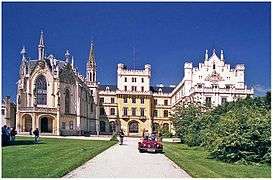 Lednice Castle
Lednice Castle- Castle Greenhouse in Lednice
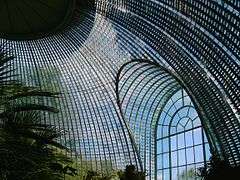 Interior of the greenhouse
Interior of the greenhouse- From the Lednice Castle garden
- Lednice Castle
Riding-Hall 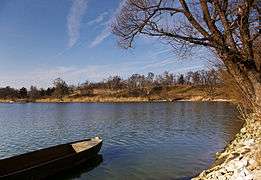 The Prostřední (Middle) one of the Lednice Ponds
The Prostřední (Middle) one of the Lednice Ponds- Valtice Castle
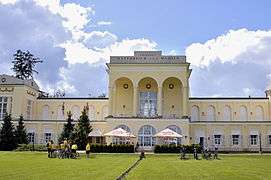 Border House.
Border House..jpg) John's Castle
John's Castle Hunting Lodge
Hunting Lodge
References
- ↑ "The former Liechtenstein possessions of Lednice-Valtice". Minor Sights. September 2014. Retrieved 4 October 2014.
- ↑ The term zámeček (German: Schlösschen, literally a small château) — is usually translated here as a "manor house" — or a "hunting lodge" (Czech: lovecký zámeček, German: Jagdschlösschen), if it served for hunting.
- ↑ World Monuments Fund – Lednice and Valtice Cultural Landscape
- ↑ Elaine Louie, New York Times, "Saving Endangered Art and Architecture," June 25, 1998.
Sources
- Kordiovský, Emil – Klanicová Evženie (eds.), Město Břeclav, Muzejní a vlastivědná společnost, Brno (2001).
- Památkový ústav v Brně: text on the reverse of a tourist map, Shocart, Zlín (1998).
External links
- UNESCO Czech heritage.org: Official Lednice-Valtice Cultural Landscape website
- World Monuments Fund.org: Conservation & Economic Enhancement Plan for Valtice Zamek & its Environs, 1993.
- World Monuments Fund.org: Conservation & Economic Enhancement Plan for Lednice Zamek & its Environs, 1995.
- Lednicko-valticky-areal.cz" Lednice-Valtice Area—(Czech)
| Wikimedia Commons has media related to Lednice–Valtice Cultural Landscape. |
Coordinates: 48°46′32.988″N 16°46′30″E / 48.77583000°N 16.77500°E